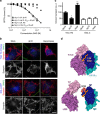Structural basis for extracellular cis and trans RPTPσ signal competition in synaptogenesis
- PMID: 25385546
- PMCID: PMC4239663
- DOI: 10.1038/ncomms6209
Structural basis for extracellular cis and trans RPTPσ signal competition in synaptogenesis
Abstract
Receptor protein tyrosine phosphatase sigma (RPTPσ) regulates neuronal extension and acts as a presynaptic nexus for multiple protein and proteoglycan interactions during synaptogenesis. Unknown mechanisms govern the shift in RPTPσ function, from outgrowth promotion to synaptic organization. Here, we report crystallographic, electron microscopic and small-angle X-ray scattering analyses, which reveal sufficient inter-domain flexibility in the RPTPσ extracellular region for interaction with both cis (same cell) and trans (opposite cell) ligands. Crystal structures of RPTPσ bound to its postsynaptic ligand TrkC detail an interaction surface partially overlapping the glycosaminoglycan-binding site. Accordingly, heparan sulphate and heparin oligomers compete with TrkC for RPTPσ binding in vitro and disrupt TrkC-dependent synaptic differentiation in neuronal co-culture assays. We propose that transient RPTPσ ectodomain emergence from the presynaptic proteoglycan layer allows capture by TrkC to form a trans-synaptic complex, the consequent reduction in RPTPσ flexibility potentiating interactions with additional ligands to orchestrate excitatory synapse formation.
Figures







References
Publication types
MeSH terms
Substances
Grants and funding
- R01HD061543/HD/NICHD NIH HHS/United States
- A10976/CRUK_/Cancer Research UK/United Kingdom
- R01 HD061543/HD/NICHD NIH HHS/United States
- G0900084/MRC_/Medical Research Council/United Kingdom
- L009609/MRC_/Medical Research Council/United Kingdom
- R01 MH070860/MH/NIMH NIH HHS/United States
- 090532/WT_/Wellcome Trust/United Kingdom
- 090532/Z/09/Z/WT_/Wellcome Trust/United Kingdom
- 10976/CRUK_/Cancer Research UK/United Kingdom
- G0700232/MRC_/Medical Research Council/United Kingdom
- G9900061/MRC_/Medical Research Council/United Kingdom
- MH070860/MH/NIMH NIH HHS/United States
- 17721/CRUK_/Cancer Research UK/United Kingdom
LinkOut - more resources
Full Text Sources
Other Literature Sources
Molecular Biology Databases

